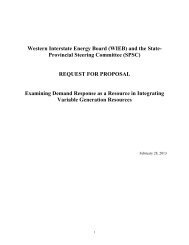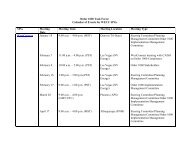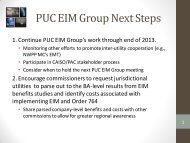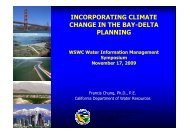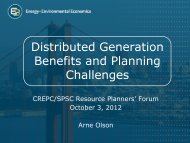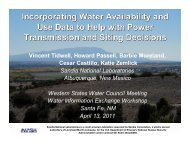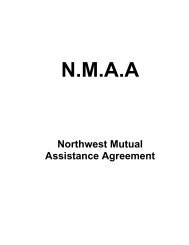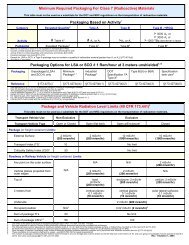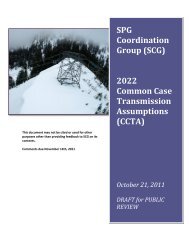WRAT Final Briefing Paper - Western Governors' Association
WRAT Final Briefing Paper - Western Governors' Association
WRAT Final Briefing Paper - Western Governors' Association
You also want an ePaper? Increase the reach of your titles
YUMPU automatically turns print PDFs into web optimized ePapers that Google loves.
egulators must make. As a part of this public process, questions regarding timeframes, target<br />
levels and to whom the targets would apply would be debated. Successful application of this<br />
approach would require that the targets be applied and evaluated at a meaningful level of WI<br />
geography. “Meaningful” refers to a level of granularity within the interconnection that<br />
allows regional, state and local regulators to focus attention on entities that are capable of<br />
taking actions to affect adequacy.<br />
<strong>Final</strong>ly, regional entities and states would agree to a common, public forum to annually review<br />
success in meeting the targets. While no authority to enforce targets would exist, the<br />
knowledge acquired through the annual review would allow individual states/provinces,<br />
control areas and LSEs to achieve outcomes through their existing market roles, authorities<br />
and mandates. It is not unreasonable to believe that the precise tradeoff each jurisdiction<br />
might make could be different, which would be acceptable if each jurisdiction were truly<br />
prepared to accept the full consequences of their decision.<br />
III.D Enforceable Standards<br />
Establish standards on an interconnection-wide basis that reflect intra-regional diversity<br />
and provide for sanctions, such as monetary penalties; require LSEs to meet appropriate<br />
regional/sub-regional standards (“enforceable standards”).<br />
This approach builds on elements of the previous three by adding a forward commitment<br />
obligation and an enforcement mechanism for the consensus target(s) developed under<br />
approach C above, e.g., a planning reserve margin of 15% at the time of summer peak loads.<br />
These would be akin to the operating reserve requirements of NERC and WECC, 11 but would<br />
be requirements to demonstrate sufficient resource commitments over some planning horizon.<br />
It could also be similar to provisions contained in the WSCC’s “power supply design criteria”<br />
(described in Section IV and Attachment C), though these were not associated with sanctions.<br />
NERC through its RTATF will soon release a study of what the member reliability councils<br />
currently require as a resource adequacy requirement, and WECC may be one of the councils<br />
required to develop explicit requirements. 12<br />
Compared to voluntary targets, an enforceable adequacy standard, rather than merely<br />
imposing additional planning costs, creates financial consequences for those LSEs who were<br />
not already covering future load with resource commitments. An enforceable standard<br />
converts the targets into an obligation to make resource commitments to serve future load and<br />
needed reserves. For this to be made functional, a decision is needed about whom the<br />
enforceable standard will apply to. If applied at the utility or load level, each LSE could be<br />
required, for example, to secure 90% of the resources required to serve forecasted requirement<br />
11 WECC’s operating reserve requirements are currently only enforceable against signers of the RMS agreement<br />
in WECC, though they are widely accepted as requirements.<br />
12 NERC Resource and Transmission Adequacy Task Force.<br />
12<br />
<strong>Final</strong> Consensus Draft<br />
Westwide Resource Assessment Team



